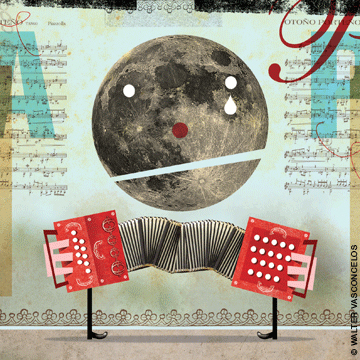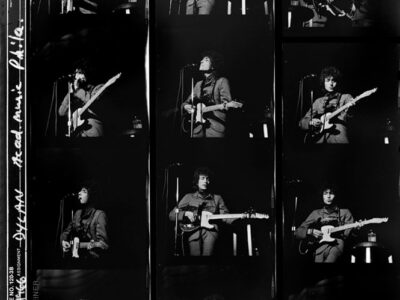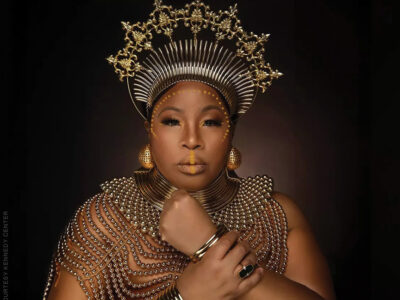
A young scholar rediscovers Astor Piazzolla.
By Karen Rile
Tim Ribchester Gr’12 first heard the nuevo tango music of Astor Piazzolla during his senior year at Oxford University. He had a page-turning gig for a performance of “Le Grand Tango,” a duet for piano and cello, and as he leaned in over the pianist’s shoulder, he was startled by the intricacy of the composition.
“I knew nothing about Piazzolla at the time, except that he was an Argentine composer who played some kind of squeezebox,” recalls Ribchester. (Piazzolla, who died in 1992 at age 71, played the bandoneón, a small keyless accordion, used in Argentine tango orchestras.) “I don’t know how I would have reacted to this music if I had merely listened and not had a chance to see the score.”
Ribchester, an active collaborative pianist and the director of adult education for the Philadelphia Orchestra, might seem an unlikely tango aficionado, with his blue eyes, reddish hair, and Scottish-tinged accent. Though born in Denver, Colorado, he grew up near Edinburgh and trained at the Royal College of Music in London while pursing a musicology degree at Oxford.
After that concert at Oxford, he found himself increasingly fascinated by Piazzolla’s compositions, both as a performer and as a musicologist. For Ribchester, the professions are inextricably entwined. He loved the jazz-influenced ensemble freedom and was drawn by Piazzolla’s complex counterpoint, which occasionally incorporated the harmonies of what he wryly calls “cheesy eighties pop.”
Soon he began experimenting with Piazzolla’s music, programming some pieces on a chamber series he launched during a stint as a staff pianist at Wells Cathedral School in Somerset, England. Back at Oxford the following year, he continued to perform Piazzolla while completing his master’s degree in musicology. His master’s thesis: Piazzolla’s tango opera, Maria de Buenos Aires.
Ribchester was drawn to Penn’s highly regarded musicology program in part because of its proximity to the Argentine diaspora of New York—where he could pick the brains of musicians who had worked with Piazzolla during his lifetime—as well as to the vibrant Philadelphia music scene. Within weeks of his arrival in 2002, he found himself running the music program at the Ethical Society on Rittenhouse Square, and was soon performing premieres of local composers, including Penn music professor Anna Weesner, Benjamin Boyle Gr’05, and Leonardo Dugan C’02 Gr’07. A few years later, he founded the Eakins Vocal Consort, a small, semi-professional chamber choir specializing in early music and contemporary commissions. Last year he formed the Arrastre Tango Ensemble, a Piazzolla-style quintet, with accordionist Lidia Kaminska.
“I feel that performance practice is essential when studying the works of any composer,” he explains. “It’s important to understand the act of using the body, making the sound.”
Piazzolla’s work has roots in the tango tradition that arose in 19th-century Argentine brothels, even though he was a classically trained composer who studied with Alberto Ginastera and Nadia Boulanger, and rubbed noses with Arthur Rubenstein. Like Bach’s minuets and sarabandes, Piazzolla’s nuevo tango retains the intrinsic gesture of the dance, even though it is not functional music for the dance hall; it is genuine Western art music, intended for listening.
“For a long time, the study of musicology was limited to what we think of as high classical art music,” says Dr. Jeffrey Kallberg, professor of music history and chair of the music department, who is Ribchester’s dissertation advisor. “But there has been a considerable loosening of this perception over the past 10 to 15 years. What I think is so interesting about Piazzolla is that his fascinating mix of classical and popular traditions help us to understand how to deal with hybridity in 20th-century music.”
In one sense, studying Piazzolla’s work would appear to be no different for Ribchester than studying Haydn or Mozart. But as a performer, there was the question of style.
“It became an intellectual conundrum for me: how, as a classically trained musician, I should play ‘in the style’ of tango,” he says. With that in mind, Ribchester traveled to Buenos Aires last summer to participate in the College Music Society’s Summer Institute.
“It was an incredibly concentrated opportunity to learn how to play the canonic dance repertoire of the 1930s,” he says. “We didn’t touch a note of Piazzolla during those weeks, but I learned about him by immersing myself in the tradition that preceded him.”
When he returned, Ribchester set to work book-ending Piazzolla historically, both in terms of his predecessors—composers such as Ginastera, Stravinsky, Villa Lobos, and Carlos Chavez (a Mexican composer who befriended Aaron Copland in the 1930s)—and his successors. Among the latter are Osvaldo Golijov Gr’91 [“Retiring Ringmaster,” Sept|Oct 2006], who acknowledges Piazzolla as one of his great influences.
But Ribchester’s research soon hit a wall, since there had been very little discussion of Piazzolla’s work within the scholarly establishment. That might seem surprising, since Piazzolla is widely performed on concert stages, thanks to such big-name soloists as Gidon Kremer and Yo Yo Ma, who have championed the composer and helped cement his oeuvre in the repertoire. What’s lacking, however, is an infrastructure that would enable performers and scholars to access the composer’s scores.
“It’s a chicken-or-egg thing, as far as the availability of resources is concerned,” Ribchester says. Until the scholarly establishment takes Piazzolla seriously, there will be no critical editions of his scores, but without critical editions, scholarship is cumbersome or impossible. Much of Piazzolla’s oeuvre remains unpublished; there is no official archive of his work, and what is available commercially comes from undocumented sources.
“His work sits on a stylistic fence at a time when our discussion of music, whether pop or classical, hinges away from style issues and is more about pigeonholing composers on a sociological or political level without addressing their stylistic nuances,” says Ribchester.
“Piazzolla loved and admired Western music and spent his career striving to be part of it,” he adds, emphasizing that while ethnography and sociology are important components of musicology, they are not substitutes for analyzing and writing about style for style’s sake. “Until Piazzolla’s historical importance as an intellectual is established, he isn’t being differentiated beyond ‘another cool sound we can use.’”
While in Argentina last year, Ribchester visited an obscure community library in Mar del Plata, the seaside village near Buenos Aires where Piazzolla was born. The Biblioteca Astor Piazzolla turned out to be a goldmine of Piazzolla source material, housing piles of photocopied manuscripts in the hand of cellist José Bragato, whom the composer paid to write out fair copies of his completed scores. During his visit, Ribchester made a catalog of the Biblioteca’s Piazzolla collection, about 300 works, and carried home copies of 42 manuscripts for further study, including such gems as the handwritten score for La Camorra (1987), a meta-quintet inspired by the Neapolitan crime family that was a breakthrough piece for the composer.
“La Camorra moves beyond his main corpus of work on a structural level, expanding the gestures into longer paragraphs and transforming their meaning,” says Ribchester, who is writing a chapter about the quintet in his dissertation, “Tango as Art Music: Piazzolla and Latin American Contrapuntal Traditions.”
The Camorra score has been published commercially, but in an edition whose murky sources make it useless for scholars. In the Mar del Plata library, Ribchester found all three movements of this work, including two in Piazzolla’s hand, with some alterations.
Ribchester’s pioneering exploration of the library’s material should help lay the foundation for future Piazzolla scholarship. It also gave him a taste of what could be accomplished if other scholars had access to its material.
“I’d like the library to develop into a real archive with full catalog, Web support, and access to scans for studying,” he says. “The Biblioteca is very quaint the way it is, and I don’t feel that it would be right to change its physical setup, but it certainly should be sharing its material electronically.”
The larger undertaking will be to establish an official Piazzolla archive, in Buenos Aires or the United States, for professional scholars. With critical editions available, non-specialist scholars could start to take greater interest in Piazzolla, whose work would then find its way into the heart of serious musicological inquiry.
In the view of Dr. Allan Atlas, Distinguished Professor of Music at the City University of New York’s Graduate Center, it’s time that musicologists paid serious attention to the music of Piazzolla, who “redefined our notions of what tango could be.” And within the musicological community, he adds, “there is hardly anyone better fitted to start the research ball rolling than Tim Ribchester, who knows the music intimately, performs it himself, and brings a thorough musicological background to the task.”
Sample the music of Astor Piazzolla
Karen Rile C’80, who teaches writing at Penn, is a frequent contributor to the Gazette and the author of Winter Music, a novel set in the classical-music world.




